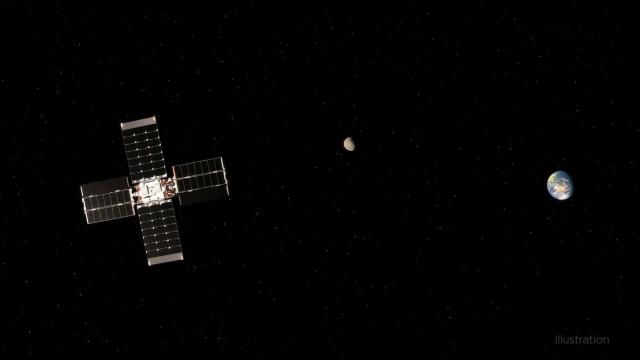NASA engineers are struggling to get a lunar probe on the right track and have until the end of April to fix the spacecraft’s thrusters so that it is able to fly over the Moon’s South Pole.
On Thursday, NASA provided the latest update on its Lunar Flashlight cubesat, which launched aboard a Falcon 9 rocket alongside Japan’s Hakuto-R lunar lander mission in December 2022. Shortly after launch, the spacecraft ran into some trouble when three of its four thrusters were underperforming on account of obstructed fuel lines. The team behind the mission have been working on ways to partially restore one or more of the Flashlight’s thrusters so that the spacecraft can stay in orbit in the Earth-Moon system, according to NASA.
NASA’s Lunar Flashlight has until the end of April to generate the thrust required to conduct monthly flybys of the lunar South Pole. The team members “have had some success but continue to try new things to clear the suspected obstructions in the thruster fuel lines,” NASA wrote in its statement. The cubesat’s remaining systems are still performing well and the mission has successfully completed all of its technology objectives.
The Lunar Flashlight is a brief-case sized satellite designed to shine infrared light on some of the Moon’s permanently shadowed areas, scanning the lunar South Pole for ice water reservoirs. The small spacecraft is using a new kind of propulsion system that has never flown in space before, which could explain why it’s been having trouble reaching lunar orbit.
“Though we hoped the propulsion system would perform perfectly, encountering and responding to these issues is an expected part of a technology demonstration mission like this,” Justin Treptow, deputy program executive for the Small Spacecraft Technology program at NASA’s Space Technology Mission Directorate, said in the statement. “Flight testing, evaluating, and troubleshooting this system all help fulfil the mission’s primary objective to explore the actual in-space performance of this novel propulsion system.”
Lunar Flashlight was originally supposed to enter a near-rectilinear halo orbit using the probe’s only unobstructed thruster. But the lone thruster encountered its own performance issues, forcing NASA to try and place the probe in a high Earth orbit instead. From there, the probe would only be able to scan the Moon’s south pole for water ice once a month instead of the original plan of once a week.
But even with the modified plan, the Lunar Flashlight is still struggling to enter lunar orbit. Hopefully the team behind the mission can resolve the issue within the next month, otherwise the Moon’s shadowed regions will remain mysterious for the time being.
